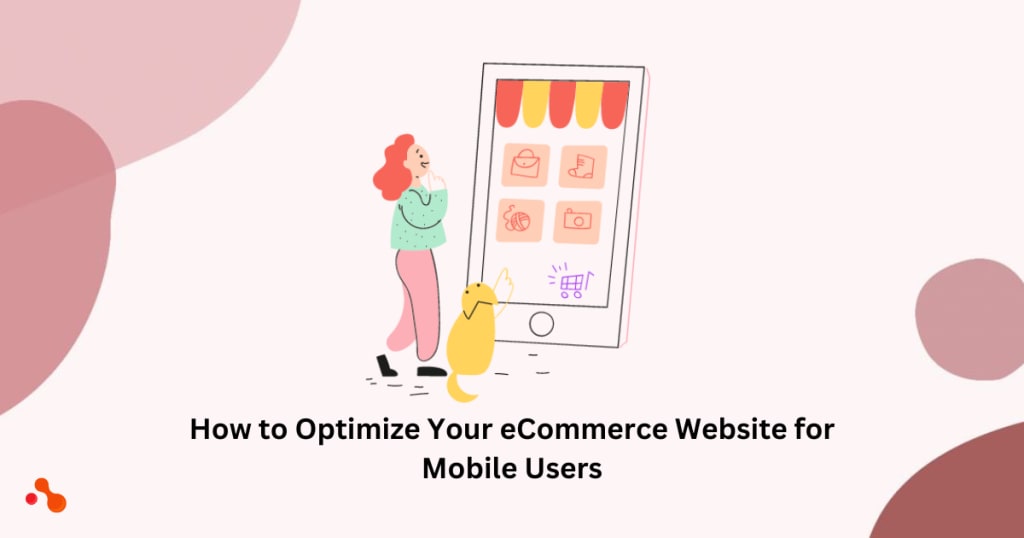How to Optimize Your eCommerce Website for Mobile Users?
Responsive web design refers to creating websites that adapt and respond to different devices and screen sizes.

Introduction
In today's digital age, having a mobile-friendly eCommerce website is crucial for business success. As more and more people use their smartphones and tablets to browse and shop online, ensuring your website provides a seamless mobile experience is essential. This blog will guide you through optimizing your eCommerce website for mobile users, focusing on key strategies and best practices. Whether you're a seasoned eCommerce development company or new to eCommerce development services, this guide will help you create a mobile-friendly website that engages and converts customers effectively.
Responsive Web Design
Responsive web design refers to creating websites that adapt and respond to different devices and screen sizes. It ensures that websites look and function well on desktop computers, tablets, smartphones, and other devices. Here are some critical points about responsive web design:
Explanation of responsive web design and its significance:
- Responsive web design is an approach to web development that focuses on creating a single website that can adjust its layout and content based on the device being used to access it.
- It aims to provide an optimal user experience by ensuring that websites are easy to read, navigate, and interact with on any screen size or device.
- Responsive design is crucial in today's digital landscape, where people access websites from various devices, and helps businesses reach a wider audience.
Tips for implementing responsive design:
1. Use a responsive framework or template: Utilize frameworks like Bootstrap or Foundation that provide pre-built responsive components and layouts.
2. Design for mobile-first: Start the design process by considering the smallest screen size and progressively enhancing the layout for larger screens.
3. Prioritize content: Identify the most critical content and ensure it is prominently displayed on all screen sizes. Avoid cluttered layouts and excessive text.
4. Optimize typography: Choose fonts that are legible on different screens and sizes. Adjust font sizes, line spacing, and line lengths to improve readability.
5. Simplify navigation: Use a clear and concise menu structure that is easy to navigate on desktop and mobile devices.
Mobile-friendly layout and navigation:
- Mobile-friendly layouts prioritize simplicity and usability. They often use vertical scrolling and stack content in a single column to fit smaller screens.
- Navigation should be easily accessible and intuitive, with options like collapsible menus or hamburger icons on mobile devices.
Flexible images and media:
- Images and media should adapt to different screen sizes. Use CSS techniques like fluid images and media queries to ensure they resize and scale appropriately.
- For example, use percentage-based widths or max-width properties instead of fixed pixel dimensions to make images fluid.
Adaptability across devices and screen sizes:
- Responsive web design ensures that websites work well across various devices, including desktops, laptops, tablets, and smartphones.
- It allows the website to adjust its layout, content, and functionality to provide a seamless experience on any screen size.
Streamlined User Experience
Mobile devices have become an integral part of our lives in today's digital world. From shopping to browsing, we rely heavily on smartphones and tablets to fulfill our daily needs. As a result, it has become increasingly important for businesses, especially e-commerce development companies, to prioritize and enhance the user experience (UX) on mobile devices. Here are some key strategies to achieve a seamless user experience:
1. Simplified Checkout Process:
- Implement a user-friendly and hassle-free checkout process to minimize cart abandonment.
- Provide a streamlined and intuitive flow that requires minimal input from the user.
- To cater to diverse customer preferences, offer multiple payment options, such as credit cards, mobile wallets, and online banking.
1. Clear Product Descriptions:
- Ensure that product information is concise, accurate, and presented in a visually appealing manner.
- Highlight key features, specifications, and benefits to help users make informed decisions.
- Include high-quality images or videos to showcase the product from different angles.
1. Easy-to-Use Search and Filtering Options:
- Implement a robust search functionality that enables users to find desired products quickly.
- Provide relevant suggestions based on popular search terms or previous searches as users type.
- Incorporate effective filtering options like price range, brand, size, color, and customer ratings.
1. Fast Loading Speed:
- Optimize website and app performance to ensure fast loading times.
- Compress images, minify code, and leverage caching techniques to reduce loading times.
- Prioritize content loading based on user interactions to enhance perceived speed.
1. Intuitive Navigation and Menu Structure:
- Design a logical and intuitive navigation system to help users explore the website or app effortlessly.
- Use clear and descriptive labels for navigation elements and avoid overcrowding the interface.
- Employ a user-centric approach to ensure the most important sections are easily accessible.
By implementing these strategies, an e-commerce development company can significantly enhance the user experience on mobile devices. A seamless and user-friendly interface will attract and retain customers, drive higher conversion rates, and ultimately lead to business growth.
Mobile Payment Integration
Mobile payment options have become increasingly important in the world of ecommerce development. They provide a convenient and efficient way for customers to purchase using their smartphones or other mobile devices. Here, we will explore the importance of mobile payment options, the integration of popular mobile payment gateways like Apple Pay and Google Pay, and the benefits they offer customers and businesses. We will also discuss the importance of ensuring secure transactions on mobile devices.
Importance of Mobile Payment Options:
- Mobile payment options allow customers to purchase anytime, anywhere, using their smartphones or mobile devices.
- They provide a seamless and convenient checkout experience, reducing the need for customers to enter their payment information manually.
- Mobile payments cater to the growing trend of customers using smartphones for shopping, enhancing the overall customer experience.
Integration of Popular Mobile Payment Gateways:
- Ecommerce development company can integrate popular mobile payment gateways like Apple Pay, Google Pay, and other digital wallets into their platforms.
- These payment gateways provide a standardized and secure way to process mobile payments.
- Integration can be done using APIs (Application Programming Interfaces) provided by the payment gateways.
Apple Pay, Google Pay, and Other Digital Wallets:
- Apple Pay and Google Pay are two widely used mobile payment solutions.
- They allow users to store their payment information securely on their mobile devices and make quick, contactless payments.
- Other digital wallets like PayPal and Samsung Pay offer similar functionality and can be integrated into ecommerce platforms.
Benefits for Customers and Businesses:
- Customers benefit from mobile payment options by enjoying a fast, hassle-free checkout experience.
- They can securely store their payment information, eliminating the need to enter it repeatedly.
- Businesses can leverage mobile payments to increase customer satisfaction, enhance conversion rates, and reduce cart abandonment.
- Mobile payments also allow businesses to reach a broader customer base by catering to mobile-centric consumers.
Ensuring Secure Transactions on Mobile Devices:
- Ecommerce development companies must prioritize security when integrating mobile payment options.
- They should implement industry-standard security measures like encryption and tokenization to protect sensitive customer data.
- Regular security audits and updates should be performed to ensure ongoing protection against potential vulnerabilities.
In conclusion, integrating mobile payment options into ecommerce platforms is crucial for providing a convenient and secure payment experience. Businesses can enhance customer satisfaction and increase conversions by integrating popular mobile payment gateways like Apple Pay, Google Pay, and other digital wallets. However, it is essential to prioritize security measures to ensure the safety of customer transactions on mobile devices.
Mobile SEO and Marketing
Introduction to Mobile SEO and Its Impact on Visibility and Traffic
- Mobile SEO refers to optimizing a website for mobile devices to improve its visibility and attract more traffic from mobile search engines.
- With the increasing use of smartphones and tablets, mobile SEO has become crucial for businesses to reach their target audience effectively.
Optimizing for Mobile Search Engines
- Mobile search engines have specific requirements and algorithms that prioritize mobile-friendly websites. Here's how you can optimize for them:
- Ensure your website is responsive and adapts to different screen sizes and resolutions.
- Optimize page loading speed for faster mobile browsing.
- Use mobile-friendly URLs that are short, descriptive, and easy to read.
- Implement structured data markup to provide additional context to search engines.
Mobile-Friendly Website Structure and Design
- A well-designed mobile website improves user experience and encourages visitors to stay longer. Consider the following aspects:
- Use a clean and uncluttered design with large, easy-to-tap buttons.
- Optimize images for mobile devices to reduce loading times.
- Ensure content is appropriately formatted and readable on smaller screens.
- Implement responsive navigation menus for seamless browsing.
Keyword Research for Mobile Queries
- Mobile users often have different search intents and behaviors compared to desktop users. Conduct keyword research specifically for mobile queries:
- Focus on localized keywords that target mobile users looking for nearby businesses or services.
- Include mobile-specific terms like "near me" or "open now."
- Consider long-tail keywords that reflect mobile users' specific needs and intentions.
Local SEO for Mobile Users
- Local SEO is crucial for businesses targeting mobile users. Here are some strategies to improve local visibility:
- Claim and optimize your Google My Business listing with accurate information and relevant keywords.
- Encourage online reviews and respond to them promptly.
- Use location-based keywords in your website content, titles, and meta descriptions.
Mobile Marketing Strategies to Attract and Engage Mobile Users
- Mobile marketing goes beyond SEO and includes various tactics to attract and engage mobile users. Consider the following strategies:
- Develop a mobile app to enhance user experience and provide value.
- Implement mobile-specific advertising campaigns to target mobile users effectively.
- Utilize social media marketing tailored for mobile devices to reach and engage your target audience.
- Use push notifications and SMS marketing to deliver personalized messages and offers directly to mobile users.
In conclusion, mobile SEO and marketing are essential for businesses aiming to effectively reach and engage mobile users. Optimizing for mobile search engines, designing mobile-friendly websites, conducting keyword research for mobile queries, implementing local SEO strategies, and utilizing mobile marketing tactics can significantly improve visibility, traffic, and conversions for an ecommerce development company or any other business.
Conclusion
In conclusion, optimizing your eCommerce website for mobile users is crucial for the success of your online business. By partnering with an eCommerce development company offering professional eCommerce development services, you can ensure your website is designed and built with mobile users in mind. This will improve the user experience, increase mobile conversions, and drive more sales. Remember, in today's mobile-centric world, prioritizing mobile optimization is essential for staying competitive and reaching a wider audience. Take advantage of the opportunity to maximize your eCommerce potential.
About the Creator
Mukesh Ram
I founded Acquaint Softtech Private Limited with a vision to make quality developers affordable to everyone. With my blood, sweat, and tears I haven’t just been able to sustain but thrive over the years.






Comments
Mukesh Ram is not accepting comments at the moment
Want to show your support? Send them a one-off tip.